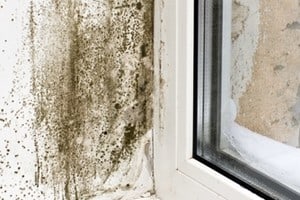
Household Mold poses a significant danger to the residents, especially children and the elderly.
When cleaning a home, it’s normal to see dust, pet hair, grease and other common buildups that simply occur through normal day to day life. Many homes, however, have a type of buildup that is much less normal and potentially much more harmful. This unwanted invader in many houses and apartments is mold. Household mold, though certainly common enough, can cause severe health complications and damage to your home, especially if it is allowed to grow unchecked over a long period of time. In this article, we’ll take a look at the adverse effects of household mold and what can be done about it.
Health Effects of Household Mold
Molds can have a wide range of different health effects, ranging from the mild to the extremely severe. Some molds simply dirty the air with spores and other secondary contaminants that, though they can certainly still cause respiratory damage over the long term, are relatively harmless in small quantities and with short exposure periods. In truth, mold spores are common enough that being outdoors for a prolonged period of time, especially in a wooded area, will probably result in some minor exposure. However, this is not the true danger of household mold. Most molds, to one degree or another, release a set of chemical compounds known collectively as mycotoxins. Mycotoxins, as the name implies, are quite literally poisonous substances that are produced by various kinds of molds.
The type and amount of mycotoxins produced by different kinds of mold are the reason that certain molds are more heavily associated with health risks than other. A prominent example of this is stachybotrys, commonly known as black mold. Chances are that at some point, someone has told you to avoid mold that is black in color because it is particularly dangerous. While this is more or less true, it’s an oversimplified truth. The real danger from stachybotrys comes not from the mold itself, but from the mycotoxins that it produces and releases into the air.
The health effects of household mold can take many forms, but usually result in damage to varying degrees of the respiratory system. In extreme cases, mycotoxicosis (effectively mold poisoning) can severely damage the absorption capacity of the lungs and leave victims more susceptible to other types of infections. Respiratory symptoms associated with mold exposure can be made worse by existing conditions such as asthma, bronchitis or previous lung damage from smoking or chemical exposure. For all of these reasons, along with the high potential that mold has to do costly damage to a home, it is important to remove household mold as soon as you become aware of its presence.
Getting Rid of Household Mold
The first step in getting rid of mold is finding it. Molds tend to like damp, dark places to grow, usually leading them to thrive in basements, unused attics and, in some cases, air ducts. A visual examination of these areas can quickly establish whether or not you have a mold problem in your home. Simply look for patchy growths of black, white or various colors of material clinging to walls or surfaces in dark and damp places. Unusual musty odors around your home can also be a good indication that there is an unseen growth of mold nearby.
Once you have found the mold, it is time to remove it. If you choose, you can do this yourself, but there are also professional mold experts that will test and remove mold growths, albeit sometimes for hefty fees. If you catch the mold in the early stages of growth, it will probably be okay to remove it yourself, but if mold has spread throughout your house, it’s time to call in a professional. To remove small patches of mold, simply wipe them down with a mixture of warm, soapy water, making sure to clean the surface thoroughly. If molds prove especially resistant, you can try diluting a small amount of bleach into water and applying it to kill off the mold with chlorine.
Whether you choose to deal with the mold yourself or have a professional remove any and all mold growths from your home, there is extensive follow-up care that can be done to make sure your home does not become infested with household mold again. One of the best ways to do this is to find and fix and leaks from the outside that may be contributing to excess moisture in your house, allowing mold to grow more readily. If moisture is a persistent problem, you can also make use of a dehumidifier to draw humidity out of the air and make it more difficult for mold to get a foothold.
You can also use air purification technology to limit your chances of mold exposure. Simple HEPA air purifiers will remove almost all mold spores from the air in your home, making it very difficult for mold to grow. Once you have cleared your home of mold, keeping it free from mold spores will go a long way toward ensuring that the mold cannot return.
Conclusion
If yours is one of the many homes around the world that is hosting an infestation of household mold, now is the time to do something about it and ensure that a small infestation now does not become a major health hazard in the future. Whether you choose to do it yourself or hire a professional mold remover, keeping your home free of household mold is an essential part of creating a healthy home environment.
Have questions about using air purification technology to keep the air you breathe clean? Don’t hesitate to contact us with your questions!